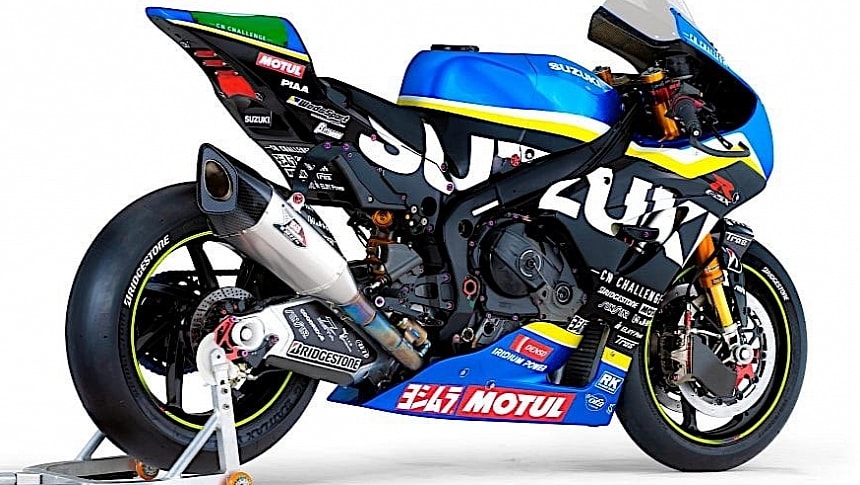Back in 1985 Japanese bike maker Suzuki introduced a motorcycle that would go on to change the face of the sportbike category forever. Called GSX-R750, the model evolved in 2001 into something ever more extraordinary, the GSX-R1000. And now it's time for the descendant of that bike, the GSX-R1000R, to once again reshape the industry.
A few months from now, in July, the Japanese circuit of Suzuka in Mie will host the 45th running of the famous, eight-hour motorcycle endurance race. As usual, the biggest names in motorcycle-making will line up on the starting grid. Including Suzuki with a very special kind of eco-friendly GSX-R1000R.
The Japanese company has always said that as far as mid to large-displacement motorcycles are concerned, combustion engines will always have a place. But that doesn't mean a bike can't turn green (or greener, to be fair) by adopting changes elsewhere.
With that in mind Suzuki announced this week a superbike project centered on the GSX-R1000R, which will be on the track of Suzuka in July with some really innovative gear.
In a bid to show everyone that one can make a race bike and still keep things green, the company installed a lot of recycled or eco-friendly materials on the motorcycle. Some of them in the unlikeliest of places.
For instance, in a bid to fight off brake dust, which believe it or not forms a large chunk of a vehicle's total emissions, low-dust pads supplied by Sunstar Engineering were installed on the GSX-R1000R.
Bridgestone supplies the tires that wrap around the two wheels, and they have a large percentage of recycled materials (no specifics were provided on that). Above each wheel, the fenders are made of a natural flax fiber sourced from a company called Bcomp. Then, the bodywork that wraps around the motorcycle, of JHI provenance, is made of recycled carbon materials.
As far as the engine is concerned, Suzuki made no hardware modifications, but it did tamper with the substances the motorcycle uses to do its thing. For instance, the fuel that will be used comes with a bio-sourced component from Elf – no less than 40 percent of the fuel is made up of this unspecified substance.
Also bio-sourced is the Motul oil the engine uses, while the emission levels are kept in check by a Yoshimura exhaust system running a catalytic converter.
The green Suzuki GSX-R1000R will race at Suzuka as part of the Team Suzuki CN Challenge team led by Shinichi Sahara. The names of the riders have not yet been announced.
Chances are that if this works according to plan, Suzuki will continue its efforts to make motorcycles greener without touching the engines or going for batteries and motors. At least that's what the Japanese are promising.
The Japanese company has always said that as far as mid to large-displacement motorcycles are concerned, combustion engines will always have a place. But that doesn't mean a bike can't turn green (or greener, to be fair) by adopting changes elsewhere.
With that in mind Suzuki announced this week a superbike project centered on the GSX-R1000R, which will be on the track of Suzuka in July with some really innovative gear.
In a bid to show everyone that one can make a race bike and still keep things green, the company installed a lot of recycled or eco-friendly materials on the motorcycle. Some of them in the unlikeliest of places.
For instance, in a bid to fight off brake dust, which believe it or not forms a large chunk of a vehicle's total emissions, low-dust pads supplied by Sunstar Engineering were installed on the GSX-R1000R.
Bridgestone supplies the tires that wrap around the two wheels, and they have a large percentage of recycled materials (no specifics were provided on that). Above each wheel, the fenders are made of a natural flax fiber sourced from a company called Bcomp. Then, the bodywork that wraps around the motorcycle, of JHI provenance, is made of recycled carbon materials.
As far as the engine is concerned, Suzuki made no hardware modifications, but it did tamper with the substances the motorcycle uses to do its thing. For instance, the fuel that will be used comes with a bio-sourced component from Elf – no less than 40 percent of the fuel is made up of this unspecified substance.
Also bio-sourced is the Motul oil the engine uses, while the emission levels are kept in check by a Yoshimura exhaust system running a catalytic converter.
The green Suzuki GSX-R1000R will race at Suzuka as part of the Team Suzuki CN Challenge team led by Shinichi Sahara. The names of the riders have not yet been announced.
Chances are that if this works according to plan, Suzuki will continue its efforts to make motorcycles greener without touching the engines or going for batteries and motors. At least that's what the Japanese are promising.













